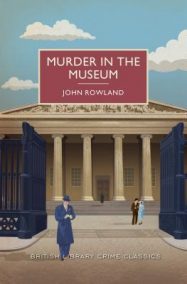-
Subscribe
Subscribed
Already have a WordPress.com account? Log in now.
 It is understandable that we, as readers, hope for everything we read to be good. However, it is also unlikely that this will be the case, and so sometimes we have to make do with what a book actually offers us. It may not be good, so is it interesting? Does it tell us something new about the era in which it is set or was written? Failing that, is it at least enjoyable? Murder in the Museum (1938), the first of two John Rowland books published as part of the British Library Crime Classics series, is not especially good, but it is a lot of fun. And I’ll take fun. Fun is underrated. I could broadside this for its many flaws and failings, but the truth is I ripped through it, didn’t take it too seriously, and had a great time.
It is understandable that we, as readers, hope for everything we read to be good. However, it is also unlikely that this will be the case, and so sometimes we have to make do with what a book actually offers us. It may not be good, so is it interesting? Does it tell us something new about the era in which it is set or was written? Failing that, is it at least enjoyable? Murder in the Museum (1938), the first of two John Rowland books published as part of the British Library Crime Classics series, is not especially good, but it is a lot of fun. And I’ll take fun. Fun is underrated. I could broadside this for its many flaws and failings, but the truth is I ripped through it, didn’t take it too seriously, and had a great time. There is a branch of Mathematics known as combinatorics which studies the interactions of countably finite discrete sets. Or, in English, it’s the formal study of combining things in all the possible ways they can be combined. It’s a little bit like doing a jigsaw by picking up one piece and then going through the box to try every other piece to find one that fits with that piece, and then going through again to find another piece that fits with those two…and so on until you’ve finished the picture. Approximately a third of the thesis I wrote in my final year of university was based in a combinatorial approach to solving a particular problem (I shall spare you the details), and the formalisation of what sounds like an exceptionally dull way to go about something took on for me a particular beauty in the context of all the mathematics I has studied to that point.
There is a branch of Mathematics known as combinatorics which studies the interactions of countably finite discrete sets. Or, in English, it’s the formal study of combining things in all the possible ways they can be combined. It’s a little bit like doing a jigsaw by picking up one piece and then going through the box to try every other piece to find one that fits with that piece, and then going through again to find another piece that fits with those two…and so on until you’ve finished the picture. Approximately a third of the thesis I wrote in my final year of university was based in a combinatorial approach to solving a particular problem (I shall spare you the details), and the formalisation of what sounds like an exceptionally dull way to go about something took on for me a particular beauty in the context of all the mathematics I has studied to that point.